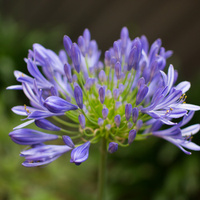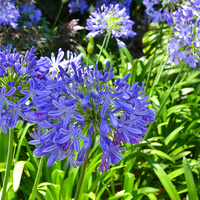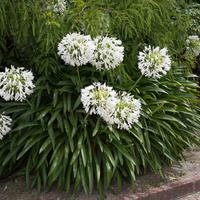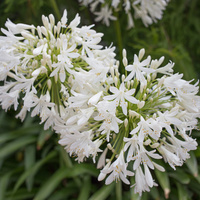Common name: Agapanthus
Other common names: African lily, Lily of the Nile
Description
Agapanthus is a perennial herb from southern Africa, widely cultivated for its showy flowers.
Its growth habit is to form clumps of plants up to 75 cm (2.5 ft) tall made up of dark green, arching sword-shaped leaves in a fountain-like arrangement. The underground parts are thick rhizomes and fleshy roots spreading off in all directions.
The flowers are funnel-shaped, up to 5 cm (2 in) long and either deep blue, lavender or, less commonly, white. They are held in a rounded cluster, atop a tall green stem high above the plant, and come into bloom from spring through summer, extending into autumn in some areas, depending on the climate.
Fertilized flowers are followed by small elongated seedpods becoming brown when dry and containing tiny, glossy black seed with a wrinkled, papery surface.
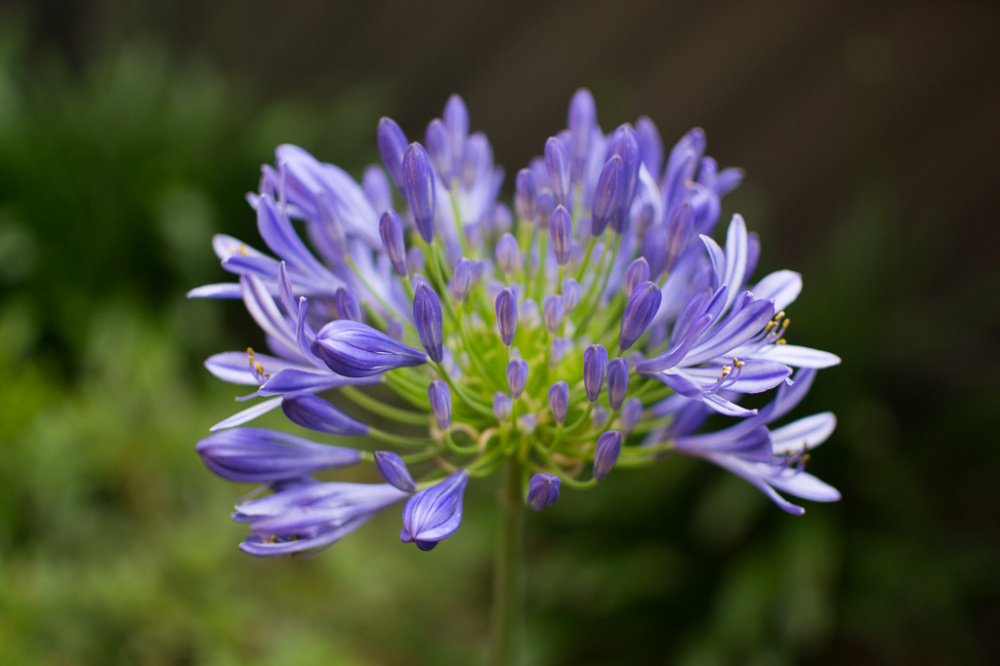
Use
Agapanthus is a commonly cultivated garden bed, ground cover or border plant for its showy flowering display. It is also ideally suited for growing in large tubs, containers and pots.
The flowering stems are suitable for floral arrangements and cut when the flowers have just started to open. Stems with the flowers falling off when shaken are usually past their prime. After cutting, the stems should stand cut-end in cold water with a floral preservative added to increase their longevity. Their vase life is about 4 to 7 days. If they are to be shipped, they should be kept cool at between 4 and 8°C (39 and 46°F).
Climate
Although naturally adapted to cool climates, Agapanthus grows and flowers reliably in moderately humid subtropical and tropical mid- to high-elevation climates, generally areas with annual lows of 8 to 20°C, annual highs of 17 to 32°C and annual rainfall of 400 to 2500 mm, extending to drier areas with irrigation.
Agapanthus may fail to flower in tropical areas where the average low of the coldest month is above 15°C (59°F).
Growing
New plants are usually started from divisions but can also be raised from seed. Seed germination is best when lightly covered and in a free-draining potting mix. They germinate in around four to six weeks and seedling plants start to flower when about two to three years old.
Agapanthus performs best on rich, free-draining loam, sandy-loam and loamy-sand soils of a moderately acid to neutral nature, generally with a pH of 6.5 to 7.5, and on sites with full to partial sun exposure.
Problem features
Agapanthus is recorded as having naturalised in more than one country but there does not appear to be any record of it anywhere as a serious weed or invasive species. It is assessed as a low weed risk species for Hawaii, by the Hawaii Pacific Weed Risk Assessment (HPWRA) project.
Where it grows
References
Books
-
Adams, C. D. 1972, Flowering plants of Jamaica, University of the West Indies, Mona, Greater Kingston
-
Chaplin, L. T. & Brandies M. M. 1998, The Florida Gardener's Book of Lists, Taylor Publishing Company, Dallas, Texas
-
Howard, T. M. 2001, Bulbs for warm climates, 1st ed, University of Texas Press, Austin
-
Hunter, N. T & Mitchell, H. 1994, The art of floral design, Delmar Publishers, Albany, New York
-
Iremonger, S. 2002, A guide to plants in the Blue Mountains of Jamaica, University of the West Indies Press, Kingston, Jamaica
-
Jones, R. 2001, Caring for cut flowers, 2nd ed, Landlinks Press, Victoria, Australia
-
Mackey, B. & Brandies, M. M., 2001, A cutting garden for Florida : grow marvelous flowers for bouquets in your Florida home landscape, 3rd edition, revised and expanded, B.B. Mackey Books, Wayne, Pennsylvania
-
Oakman, H. 1995, Harry Oakman's what flowers when : the complete guide to flowering times in tropical and subtropical gardens, University of Queensland Press, St. Lucia, Queensland
-
Perry, B. 2010, Landscape plants for California gardens: an illustrated reference of plants for California landscapes, Land Design Publishing, Claremont, California
-
Perry, F. & Hay, R. 1982, A field guide to tropical and subtropical plants, Van Nostrand Reinhold Company, New York
-
Randall, R. P. 2002, A global compendium of weeds, R.G. and F.J. Richardson Press, Melbourne
-
Randall, R. P. 2007, The introduced flora of Australia and its weed status, Cooperative Research Centre for Australian Weed Management, Glen Osmond, South Australia
-
Smith, P. P. 2018, The book of seeds : a life-size guide to six hundred species from around the world, The University of Chicago Press, Chicago
-
Standley P. C., & Steyermark J. A. 1946 to 1976, Flora of Guatemala (25 volumes), Botany series publication (Chicago Field Museum of Natural History), Chicago, Illinois
